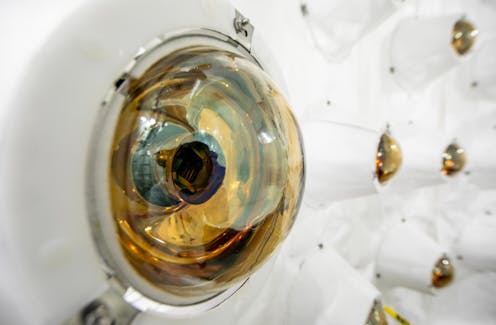85% of the matter in the universe is missing. But we’re getting closer to finding it
- Written by Theresa Fruth, Lecturer in Physics, University of Sydney

Most of the matter in the universe is missing. Scientists believe around 85% of the matter in the cosmos is made of invisible dark matter, which has only been detected indirectly by its gravitational effects on its surroundings.
My colleagues and I – a team of some 250 scientists from around the world working on a dark matter experiment called LUX-ZEPLIN (or LZ) – today report our latest findings from the long quest to discover exactly what this dark matter is made of.
We have not yet found the elusive particles we believe dark matter consists of, but we have set the tightest limits yet on their properties. We have also shown our detector is working as expected – and should produce even better results in the future.
Our results are reported today at the TeV Particle Astrophysics 2024 conference in Chicago and the LIDINE 2024 conference in São Paulo, Brazil. A journal paper will be submitted for peer review in the coming weeks.
What is dark matter?
When astronomers look at the universe, they see evidence that the visible matter of stars, gas and galaxies is not all there is. Many phenomena, such as how fast galaxies spin and the pattern of the residual glow of the Big Bang, can only be explained by the presence of large amounts of some invisible substance – dark matter.
So what is this dark matter made of? We currently don’t know of any kind of particle that could explain these astronomical observations.
There are dozens of theories that aim to explain dark matter observations, ranging from exotic unknown particles to tiny black holes or fundamental changes to our theory of gravity. However, none of them has yet been proven correct.
One of the most popular theories suggests dark matter is made up of so-called “weakly interacting massive particles” (or WIMPs). These relatively heavy particles could cause the observed gravitational effects and also – very rarely – interact with ordinary matter.
How would we know if this theory is correct? Well, we think these particles must be streaming through Earth all the time. For the most part, they will pass through without interacting with anything, but every so often a WIMP might crash directly into the nucleus of an atom – and these collisions are what we are trying to spot.
A big cold tank of liquid xenon
The LZ experiment is located in an old goldmine about 1,500 metres below ground in South Dakota in the US. Placing the experiment deep underground helps to cut out as much background radiation as possible.
The experiment consists of a large double-walled tank filled with seven tonnes of liquid xenon, a noble gas chilled down to a temperature of 175 kelvin (–98°C).
If a dark matter particle smacks into a xenon nucleus, it should give off a tiny flash of light. Our detector has 494 light sensors to detect these flashes.
Scientists complete building the sensor array for the LZ experiment.Of course, dark matter particles aren’t the only things that can create these flashes. There is still some background radiation from the surroundings and even the materials of the tank and detectors themselves.
A big part of figuring out whether we are seeing signs of dark matter is disentangling this background radiation from anything more exotic. To do this, we make detailed simulations of the results we would expect to see with and without dark matter.
These simulations have been the focus of much of my part in the experiment, which began when I started my PhD in 2015. I also developed detector monitoring sensors and was responsible for the integration and commissioning of the central detector underground, which began collecting data in 2021.
Drawing the net tighter
Our latest results show no signs of dark matter. However, they let us rule out a lot of possibilities.
We found no traces of particles with masses above 1.6 × 10–26 kilograms, which is about ten times as heavy as a proton.
These results are based on 280 days’ worth of observations from the detector. Eventually, we aim to collect 1,000 days’ worth – which will let us search for even more elusive potential dark matter particles.
If we’re lucky, we might find dark matter turns up in the new data. If not, we have already begun to make plans for a next generation dark matter experiment. The XLZD (XENON-LUX-ZEPLIN-DARWIN) consortium is aiming to build a detector almost ten times bigger that would allow us to trawl through even more of the space where these ubiquitous yet elusive particles may be hiding.
Authors: Theresa Fruth, Lecturer in Physics, University of Sydney





